Introduction
In the rapidly evolving landscape of healthcare, effective marketing strategies are no longer optional but essential for success. With patients increasingly seeking personalized experiences and relevant information, healthcare organizations must move beyond generic marketing approaches.
This article delves into the significance of tailored marketing strategies, explores key digital tactics that drive patient engagement, and highlights the importance of compliance with regulatory standards. By leveraging data analytics and building a strong online presence, healthcare providers can enhance their visibility and foster trust with potential patients.
Understanding these components is crucial for navigating the complex healthcare marketing environment and achieving sustainable growth.
The Importance of Tailored Healthcare Marketing Strategies
In the healthcare sector, utilizing healthcare digital marketing strategies rather than a one-size-fits-all approach to promotion can help avoid missed opportunities and enhance communication. Customized healthcare digital marketing strategies that address the specific requirements of the target audience—including demographics, medical issues, and local rivals—are crucial for success. For instance, statistics indicate that 16 percent of consumers scheduled appointments using a client portal, underscoring the effectiveness of personalized marketing strategies in driving engagement.
Moreover, a 2022 Healthcare Marketers Study revealed a disconnect between individuals’ priorities—such as insurance coverage, location, and availability of new clients—and the effectiveness of healthcare digital marketing strategies as perceived by marketers. By understanding these factors, medical organizations can develop healthcare digital marketing strategies that not only improve client engagement but also strengthen their overall brand reputation. For example, a clinic specializing in pediatric care might center its messaging around family-friendly values and child health, while a facility focusing on specialized surgical services would likely highlight its expertise and impressive success rates.
As noted in ‘The State of AI in Digital Marketing Report,’ over 40% of marketers see AI as a potential job threat, but a remarkable 97% believe it will enhance their careers. This level of customization, aided by advancements in AI, is crucial for building trust and credibility with prospective patients, ultimately leading to improved patient satisfaction and retention.
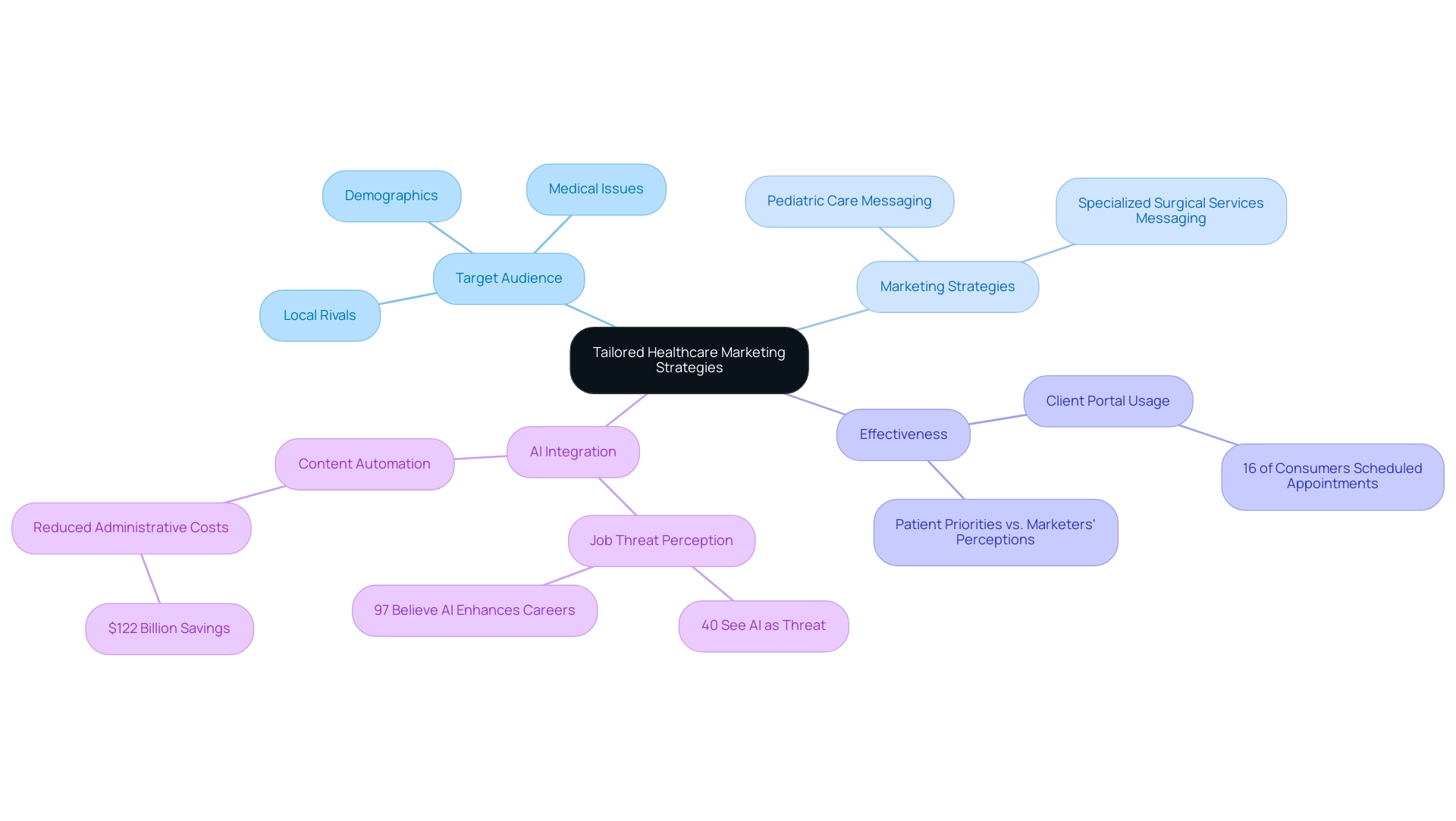
Key Digital Marketing Tactics for Healthcare Success
Successful medical digital marketing hinges on various key tactics, including:
-
Search Engine Optimization (SEO): Effective SEO practices are vital for ensuring that medical providers rank prominently in search results. Marketers acknowledge that 70% of individuals prioritize a doctor’s experience when searching for healthcare. This statistic emphasizes the significance of healthcare digital marketing strategies; by optimizing website content for relevant keywords, providers can enhance their visibility to potential clients seeking medical information, thereby improving client acquisition and ensuring that their experience is prominently highlighted in search results.
-
Content Marketing: Providing valuable content, such as informative blog articles and educational materials, establishes authority and builds trust. As noted by Pete Kiehart,
Not convinced yet? Here, we share the top medical marketing statistics of 2024 to show how content marketing can help guide one through an increasingly-complicated landscape.
This approach not only enhances patient engagement but also aligns with healthcare digital marketing strategies, leading to improved search rankings. Integrating compelling content is essential for medical providers to effectively showcase their expertise and the quality of care they offer through healthcare digital marketing strategies. -
Social Media Engagement: Platforms like Facebook and Instagram serve as essential tools for healthcare organizations. They enable direct communication with individuals, allowing practices to share updates, health tips, and promote community events. Engaging with individuals through these channels fosters a sense of community and encourages ongoing interaction with the practice.
-
Email Marketing: Regular email newsletters are instrumental in keeping individuals informed about new services, health tips, and upcoming events. Customized email campaigns have been demonstrated to greatly improve patient retention by providing tailored messages that connect with individual patient needs.
-
Pay-Per-Click Advertising (PPC): This tactic enables medical providers to reach specific demographics effectively. By investing in healthcare digital marketing strategies, practices can drive traffic to their websites and subsequently increase appointment bookings. The strategic use of PPC can yield substantial returns on investment, particularly when combined with optimized landing pages and a clear call to action.
-
Health Promotion Automation: Automation tools have transformed the effectiveness of medical outreach. A notable case study revealed that implementing content automation led to a remarkable reduction in administrative costs, amounting to $122 billion. This substantial cost decrease not only streamlines operations but also enables leaders to allocate resources more effectively towards innovative marketing strategies, enhancing overall marketing effectiveness and outreach.
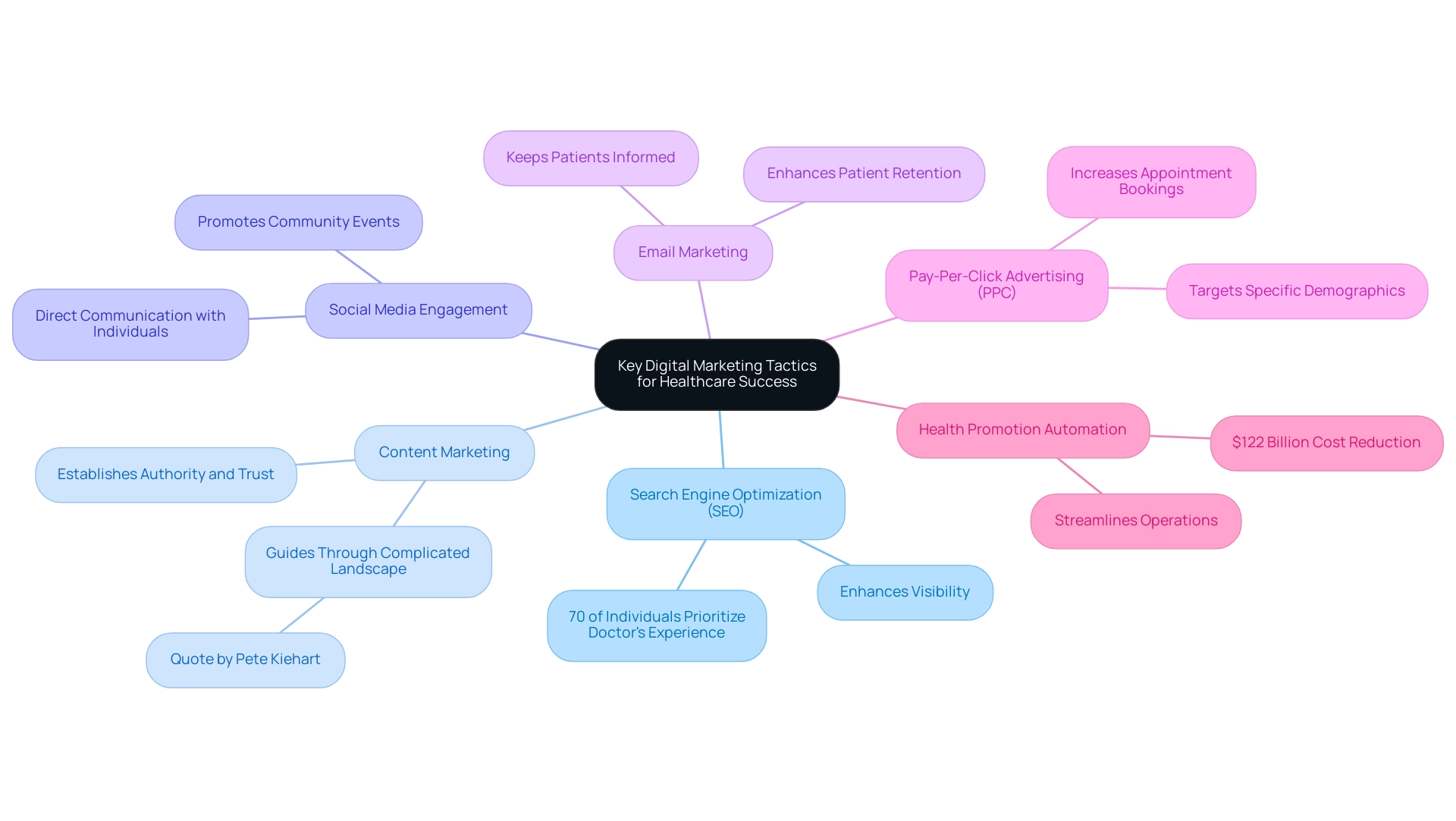
Navigating Regulatory Compliance in Healthcare Marketing
Healthcare marketers must navigate a complex landscape of regulations governing advertising and privacy, particularly the Health Insurance Portability and Accountability Act (HIPAA) and Federal Trade Commission (FTC) guidelines. Non-compliance can lead to severe penalties and irreparable damage to an organization’s reputation. For instance, in 2008, Providence Health & Services faced a settlement of $100,000 due to HIPAA violations, highlighting the financial repercussions of regulatory non-adherence.
Similarly, Health Net Inc. was fined $250,000 in 2010 for similar reasons. In 2023, a breach reported by Managed Care of North America affected 8,627,242 individuals, underscoring the critical need for compliance to protect patient data. To mitigate these risks and ensure compliance, healthcare promoters should implement the following strategies:
- Training Staff: Regular training sessions focused on compliance regulations for promotional teams are essential. This proactive approach helps staff understand the importance of adhering to legal standards and reduces the likelihood of violations.
- Reviewing Content: All promotional materials should undergo thorough review by legal counsel to ensure they conform to applicable laws. This step is essential in upholding compliance and safeguarding individual data.
- Transparency: Clearly communicating how individual information is utilized in promotional efforts fosters trust and ensures adherence to privacy regulations. Transparency is essential for establishing enduring connections with patients and upholding a positive reputation.
The environment of healthcare promotion is continually changing, requiring a persistent dedication to comprehending updates on HIPAA and FTC guidelines. As Derek Andersen aptly pointed out, despite a modest 6.11% click-through rate, hospitals dedicate an astounding 85% of their promotional budget to Google Ads. This demonstrates the tension between promotional expenditures and the need for rigorous compliance measures.
Achieving a balance between effective promotional approaches, including healthcare digital marketing strategies, and compliance with regulatory standards is crucial to protect both organizational integrity and trust from those receiving care.
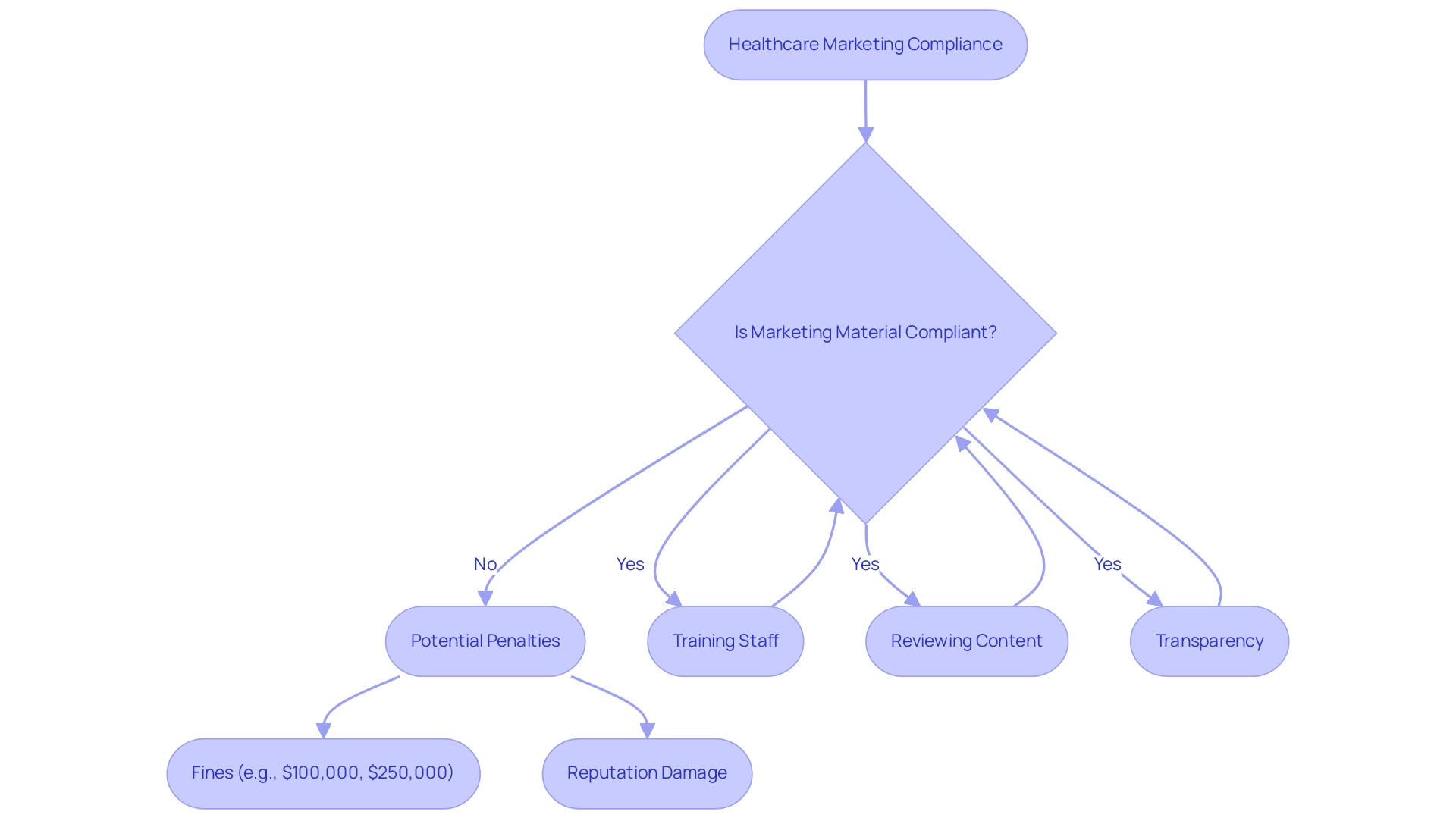
Leveraging Data Analytics for Effective Marketing Decisions
Data analysis is vital for enhancing healthcare digital marketing strategies. By closely examining metrics such as website traffic, conversion rates, and user demographics, organizations can derive critical insights that enhance the effectiveness of their promotional campaigns. Key approaches in this arena include:
- Tracking User Behavior: Analyzing how patients engage with websites offers valuable information that can shape design and content strategies, ultimately improving user experience and engagement.
- A/B Testing: This method involves experimenting with various promotional messages to determine which resonates most strongly with the target audience. Its application can significantly enhance the impact of campaigns, as evidenced by ongoing trends in healthcare promotion.
- Feedback from Clients: Actively soliciting insights through surveys and reviews provides direct feedback on client satisfaction and highlights areas needing improvement. This information is vital for enhancing future marketing efforts and ensuring they align with consumer expectations.
Recent findings highlight the application of healthcare digital marketing strategies, revealing that 35.24% of organizations utilize data to guide business decisions, and 40.09% for clinical decisions, illustrating a growing reliance on data-driven practices in the medical field. Implementing healthcare digital marketing strategies and Big Data analytics can lower costs, improve diagnoses, and enhance patient care, providing significant advantages for medical organizations. However, challenges persist with Big Data analytics, including issues related to data capture, storage, analysis, and visualization.
Tackling these challenges is crucial for optimizing the potential advantages of data analytics in medical promotion. As John Doe noted, “Over 40% of marketers see AI as a potential job threat, but here’s the good news: a whopping 97% believe it will enhance their careers!” This perspective highlights the transformative role of technology and data analytics in shaping the future of medical marketing.
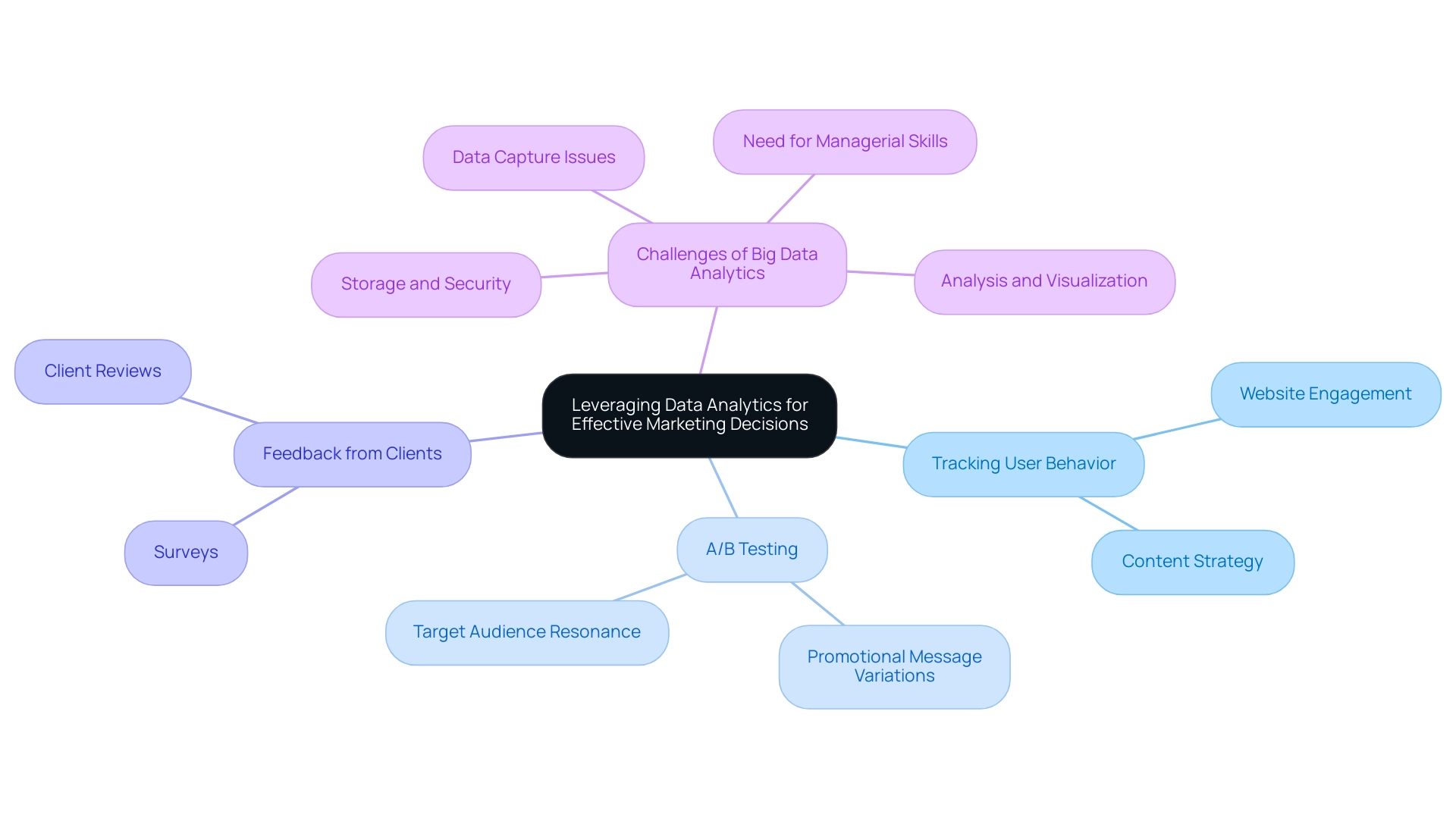
Building a Strong Online Presence in Healthcare Marketing
In the contemporary digital landscape, effective healthcare digital marketing strategies are essential for medical organizations to establish a formidable online presence. Access to reliable content and prompt medical information has become a top priority for the public, making it essential for medical marketers to adopt effective healthcare digital marketing strategies. To enhance visibility and attract clients, consider the following strategies:
-
Optimizing Website Design: Crafting a user-centric website that is both mobile-responsive and intuitive is crucial for improving engagement. A well-structured site not only facilitates navigation but also ensures that individuals can access information effortlessly.
-
Local SEO: Prioritizing local search engine optimization is vital for healthcare providers. By optimizing listings on Google My Business and local directories, organizations can significantly increase their chances of appearing in local search results, thus attracting individuals in their vicinity.
-
Engaging Content: Consistently publishing high-quality content—such as informative blogs, engaging videos, and authentic testimonials—can greatly enhance an organization’s credibility. With Facebook being the most popular social media platform among over 1,500 hospitals, focusing efforts on social media can foster interaction and build trust with potential clients, demonstrating a commitment to providing valuable information.
-
Online Reputation Management: Proactively managing online reviews and addressing feedback is essential for maintaining a positive public image. By addressing feedback promptly, medical organizations can effectively alleviate concerns and demonstrate their commitment to client satisfaction. Despite a meager 6.11% click-through rate, hospitals dedicate a staggering 85% of their marketing budget to Google Ads, highlighting the significance of healthcare digital marketing strategies in establishing a robust online presence, which is increasingly becoming a determining factor in patient choice and trust in healthcare services.
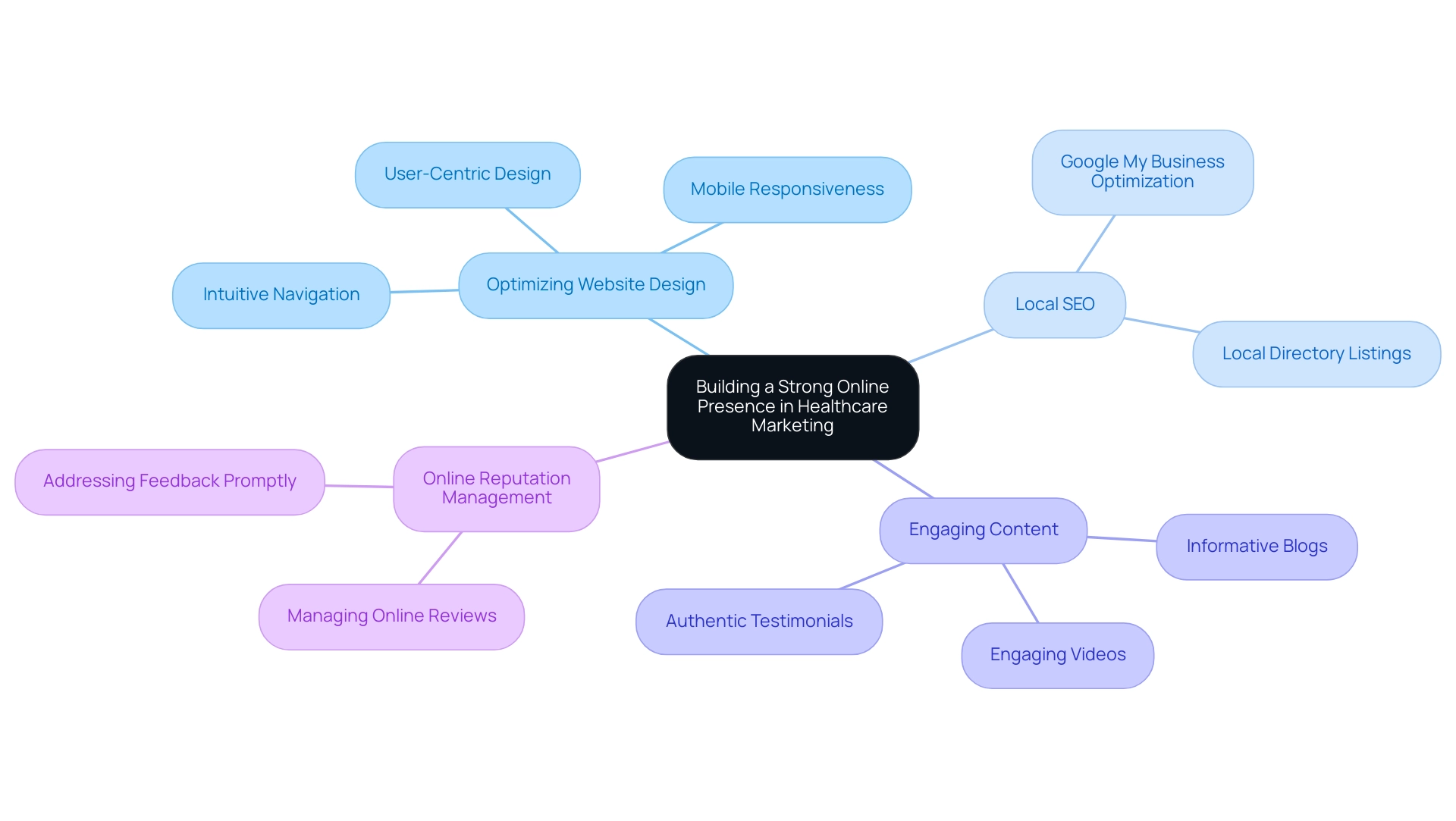
Conclusion
Tailored marketing strategies are crucial for healthcare organizations aiming to connect effectively with their target audiences. By moving away from generic approaches and focusing on specific demographics, medical concerns, and local competition, providers can significantly enhance patient engagement and satisfaction. The integration of advanced digital tactics such as SEO, content marketing, and social media engagement plays a vital role in driving visibility and trust. These strategies not only attract new patients but also foster loyalty among existing ones.
Navigating the regulatory landscape is equally important. Compliance with laws like HIPAA ensures that patient data is handled responsibly, protecting both the organization’s reputation and the trust of its patients. Healthcare marketers must prioritize ongoing education and transparency in their practices to mitigate risks and enhance their credibility.
Data analytics further empowers healthcare organizations to refine their marketing approaches. By leveraging insights into patient behavior and preferences, providers can craft more effective campaigns that resonate with their audience. Embracing these analytics not only aids in strategic decision-making but also promotes continuous improvement in patient care and marketing effectiveness.
In conclusion, as the healthcare marketing landscape continues to evolve, organizations must adopt a multifaceted approach that combines tailored strategies, regulatory compliance, data-driven insights, and a strong online presence. This comprehensive methodology is essential for achieving sustainable growth and ensuring that healthcare providers meet the increasingly personalized demands of patients in today’s digital age.

